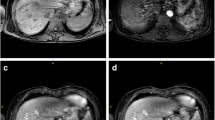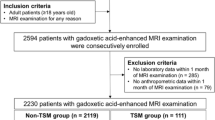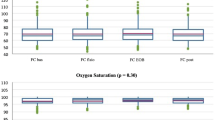Abstract
Objective
To compare the frequency of transient arterial-phase respiratory-motion-related artifacts in liver MRI after extracellular gadolinium and gadoxetic acid injection, and to determine the impact of these artifacts on the detection of focal areas of enhancement on arterial-phase images.
Materials and methods
Intra-patient comparison of 82 cirrhotic patients who prospectively underwent liver MR with extracellular gadolinium and with gadoxetic acid within 1 month. Two readers independently assessed the quality of dynamic T1-weighted MR images (pre-contrast, arterial, and portal-venous phases), rating respiratory-motion-related artifacts on four-point scale (0 [none]–3 [non-diagnostic]). We dichotomized these assessments, which were compared using McNemar’s test, defining transient arterial-phase respiratory-motion-related artifacts as a study with a pre-contrast score < 2 and arterial-phase score ≥ 2. Readers also recorded whether at least one focal area of enhancement ≥ 10 mm on arterial phase was present.
Results
The quality of arterial-phase images was worse when obtained after gadoxetic acid than after extracellular gadolinium (p < 0.01), and transient arterial-phase respiratory-motion-related artifacts were more common after gadoxetic acid than after extracellular gadolinium (p < 0.02). At least one area of arterial-phase enhancement ≥ 10 mm was detected more often after extracellular gadolinium than after gadoxetic acid. We observed significant differences on the comparison of the distributions of the presence of arterial-phase artifacts against the presence of arterial-phase enhancement ≥ 10 mm between the two contrast agents (p < 0.0001).
Conclusion
In cirrhotic patients, transient arterial-phase respiratory-motion-related artifacts are more common after gadoxetic acid than after extracellular gadolinium. Worse detection of arterial-phase enhancement on gadoxetic acid is only partly due to these artifacts.
Key Points
• In a patient-by-patient analysis, the quality of arterial-phase liver MR images was significantly worse with gadoxetic acid than with extracellular gadolinium.
• The frequency of transient arterial-phase artifacts was significantly higher after gadoxetic acid injection than after extracellular gadolinium injection.
• Differences in the detection of areas of arterial-phase enhancement between MRI studies done with extracellular gadolinium and those done with gadoxetic acid might not be related only to image quality.


Similar content being viewed by others
Abbreviations
- AASLD:
-
American Association for the Study of Liver Diseases
- CI:
-
Confidence interval
- EASL:
-
European Association for the Study of the Liver
- HCC:
-
Hepatocellular carcinoma
- IQR:
-
Interquartile range
- MR:
-
Magnetic resonance
References
Van Beers BE, Pastor CM, Hussain HK (2012) Primovist, Eovist: what to expect? J Hepatol 57:421–429
Gschwend S, Ebert W, Schultze-Mosgau M, Breuer J (2011) Pharmacokinetics and imaging properties of Gd-EOB-DTPA in patients with hepatic and renal impairment. Invest Radiol 46:556–566
Roberts LR, Sirlin CB, Zaiem F et al (2018) Imaging for the diagnosis of hepatocellular carcinoma: a systematic review and meta-analysis. Hepatology 67:401–421
European Association for the Study of the Liver (2018) EASL clinical practice guidelines: management of hepatocellular carcinoma. J Hepatol 69:182–236
Marrero JA, Kulik LM, Sirlin CB et al (2018) Diagnosis, staging, and management of hepatocellular carcinoma: 2018 Practice Guidance by the American Association for the Study of Liver Diseases. Hepatology 68:723–750
Davenport MS, Caoili EM, Kaza RK, Hussain HK (2014) Matched within-patient cohort study of transient arterial phase respiratory motion-related artifact in MR imaging of the liver: gadoxetate disodium versus gadobenate dimeglumine. Radiology 272:123–131
Davenport MS, Al-hawary MM, Caoili EM et al (2013) Comparison of acute transient dyspnea after intravenous administration of gadoxetate disodium and gadobenate phase image quality. Radiology 266:452–461
Kim YK, Lin W-C, Sung K et al (2017) Reducing artifacts during arterial phase of gadoxetate disodium – enhanced MR imaging : dilution method versus reduced injection rate. Radiology 283:429–437
Davenport MS, Bashir MR, Pietryga JA, Weber JT, Khalatbari S, Hussain HK (2014) Dose-toxicity relationship of gadoxetate disodium and transient severe respiratory motion artifact. AJR Am J Roentgenol 203:796–802
Pietryga JA, Burke LMB, Marin D et al (2014) Phase imaging with gadoxetate disodium : examination recovery with a multiple arterial phase acquisition. Radiology 271:426–434
Shah MR, Flusberg M, Paroder V, Rozenblit AM, Chernyak V (2017) Transient arterial phase respiratory motion-related artifact in MR imaging of the liver : an analysis of four different gadolinium-based contrast agents. Clin Imaging 41:23–27
Motosugi U, Bannas P, Bookwalter C, Sano K, Reeder SB (2016) An investigation of transient severe motion related to gadoxetic acid–enhanced MR imaging. Radiology 279:93–102
Sim KC, Park BJ, Han NY, Sung DJ, Kim MJ, Han YE (2019) Effects of gadoxetic acid on image quality of arterial multiphase magnetic resonance imaging of liver : comparison study with gadoteric acid - enhanced MRI. Abdom Radiol (NY). https://doi.org/10.1007/s00261-019-02202-0
Ayuso C, Forner A, Darnell A et al (2019) Prospective evaluation of gadoxetic acid magnetic resonance for the diagnosis of hepatocellular carcinoma in newly detected nodules ≤ 2 cm in cirrhosis. Liver Int 39:1281–1291
Rimola J, Forner A, Sapena V et al (2019) Performance of gadoxetic acid MRI and diffusion-weighted imaging for the diagnosis of early recurrence of hepatocellular carcinoma. Eur Radiol 30:186–194
Landis JR, Koch GG (1977) The measurement of observer agreement for categorical data. Biometrics 33:159–174
Bashir MR, Castelli P, Davenport MS et al (2015) Respiratory motion artifact affecting hepatic arterial phase MR imaging with gadoxetate disodium is more common in patients with a prior episode of arterial phase motion associated with gadoxetate disodium. Radiology 274:141–148
Bashir MR, Gupta RT, Davenport MS et al (2013) Hepatocellular carcinoma in a north American population : does hepatobiliary MR imaging with Gd-EOB-DTPA improve sensitivity and confidence for diagnosis ? J Magn Reson Imaging 406:398–406
Kim SY, Park SH, Wu E et al (2015) Transient respiratory motion artifact during arterial phase MRI with gadoxetate disodium: risk factor analyses. AJR Am J Roentgenol 204:1220–1227
Chernyak V, Fowler MSKJ, Kamaya A et al (2018) Liver Imaging Reporting and Data System ( LI-RADS ) version 2018 : imaging of hepatocellular carcinoma in at-risk patients. Radiology 289:816–830
Brismar TB, Dahlström N, Edsborg N, Persson A, Smedby O, Albiin N (2009) Liver vessel enhancement by Gd-BOPTA and Gd- EOB-DTPA : a comparison in healthy volunteers. Acta Radiol 50:709–715
Tamada T, Ito K, Sone T et al (2009) Dynamic contrast-enhanced magnetic resonance imaging of abdominal solid organ and major vessel: comparison of enhancement effect between Gd-EOB-DTPA and Gd-DTPA. J Magn Reson Imaging 29:636–640
Motosugi U, Ichikawa T, Sou H et al (2009) Liver parenchymal enhancement of hepatocyte-phase images in Gd-EOB-DTPA-enhanced MR imaging: which biological markers of the liver function affect the enhancement? J Magn Reson Imaging 30:1042–1046
Son J, Hwang SH, Park S et al (2019) Imaging features of hepatocellular carcinoma: quantitative and qualitative comparison between MRI-enhanced with Gd-EOB-DTPA and Gd-DTPA. Invest Radiol 54:494–499
Funding
This study has not received funding.
Author information
Authors and Affiliations
Corresponding author
Ethics declarations
Guarantor
The scientific guarantor of this publication is Jordi Rimola.
Conflict of interest
The authors of this manuscript declare no relationships with any companies whose products or services may be related to the subject matter of the article.
Statistics and biometry
Victor Sapena kindly provided statistical advice for this manuscript.
Informed consent
Written informed consent was obtained from all subjects (patients) in this study.
Ethical approval
Institutional Review Board approval was obtained (HCB/2019/1021).
Methodology
• prospective
• diagnostic or prognostic study
• performed at one institution
Additional information
Publisher’s note
Springer Nature remains neutral with regard to jurisdictional claims in published maps and institutional affiliations.
Rights and permissions
About this article
Cite this article
Rimola, J., Darnell, A., Belmonte, E. et al. Does transient arterial-phase respiratory-motion-related artifact impact on diagnostic performance? An intra-patient comparison of extracellular gadolinium versus gadoxetic acid. Eur Radiol 30, 6694–6701 (2020). https://doi.org/10.1007/s00330-020-07039-6
Received:
Revised:
Accepted:
Published:
Issue Date:
DOI: https://doi.org/10.1007/s00330-020-07039-6




